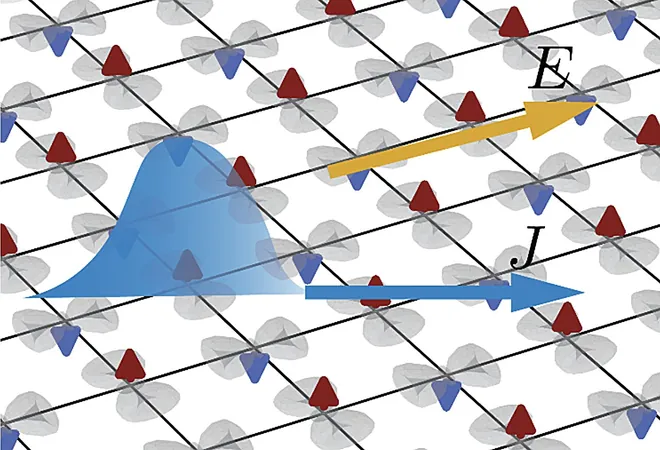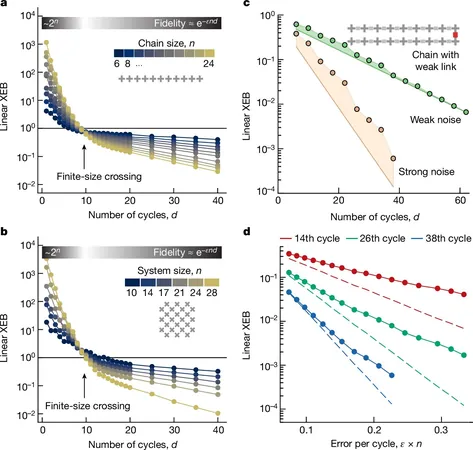
Groundbreaking Discovery: Quantum Geometry Sparks Nonlinear Transport in Altermagnets!
2024-10-11
Author: Wei Ling
Groundbreaking Discovery: Quantum Geometry Sparks Nonlinear Transport in Altermagnets!
In an exciting breakthrough for the field of materials science and quantum physics, researchers have been delving into the fascinating world of altermagnets—an emerging category of magnetic materials that challenge our understanding of magnetism. Unlike traditional ferromagnets and antiferromagnets, altermagnets exhibit a unique magnetic behavior characterized by electrons whose spin is intrinsically linked to their momentum. This novel property makes them ideal candidates for next-generation spintronic and electronic devices, potentially revolutionizing technology as we know it.
A team of researchers at Stony Brook University has made significant strides in unraveling the nonlinear transport mechanisms within these planar altermagnets. Their recent publication in *Physical Review Letters* highlights a groundbreaking observation: the nonlinear response in these materials is intricately connected to quantum geometry.
Sayed Ali Akbar Ghorashi, one of the co-authors, shared insights into their findings with Phys.org: "Our work aimed to shed light on the nonlinear response of altermagnets, particularly how quantum geometry plays a role in this phenomenon." He explained that unlike conventional PT-symmetric antiferromagnets, altermagnets do not possess the same symmetries, making their study a fresh challenge.
The research involved calculating the various contributions to the nonlinear response of altermagnets, applying advanced semiclassical Boltzmann theory techniques. Ghorashi expressed astonishment at their results, stating, "We found that altermagnets exhibit a giant third-order nonlinear response, a unique characteristic derived from their quantum metric."
This discovery has major implications. Altermagnets uniquely possess a vanishing second-order response due to their inversion symmetry, marking them as the first materials where the third-order nonlinear response not only dominates but also harnesses their substantial spin-splitting effect. Such properties could redefine our approach toward understanding transport characteristics in this new class of materials, which has primarily focused on linear anomalous Hall conductivity until now.
The relevance of this research extends beyond theoretical implications. The unique quantum geometry of altermagnets could pave the way for innovative applications in spintronics, paving a path toward faster and more efficient electronic devices. Its potential in quantum computing also cannot be overlooked, as researchers aim to explore the rich physics hidden within these materials.
Looking to the future, Ghorashi and his team intend to explore the influence of disorder on these materials, a phenomenon already well-studied in PT-symmetric antiferromagnets and known to spice up the underlying physics.
In summary, the research on altermagnets not only advances our comprehension of quantum geometric effects but also opens new doors to potential technological advancements, promising exciting developments in the field of quantum materials.
Stay tuned as this groundbreaking research continues to unfold, sparking new theories and experiments that could change the landscape of material science forever!





 Brasil (PT)
Brasil (PT)
 Canada (EN)
Canada (EN)
 Chile (ES)
Chile (ES)
 España (ES)
España (ES)
 France (FR)
France (FR)
 Hong Kong (EN)
Hong Kong (EN)
 Italia (IT)
Italia (IT)
 日本 (JA)
日本 (JA)
 Magyarország (HU)
Magyarország (HU)
 Norge (NO)
Norge (NO)
 Polska (PL)
Polska (PL)
 Schweiz (DE)
Schweiz (DE)
 Singapore (EN)
Singapore (EN)
 Sverige (SV)
Sverige (SV)
 Suomi (FI)
Suomi (FI)
 Türkiye (TR)
Türkiye (TR)